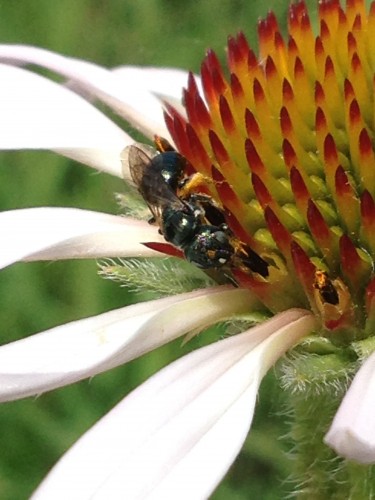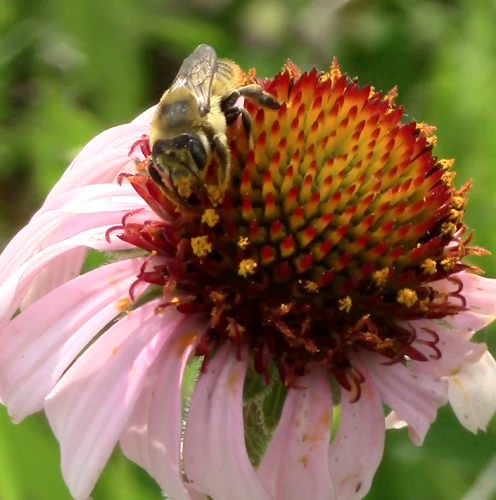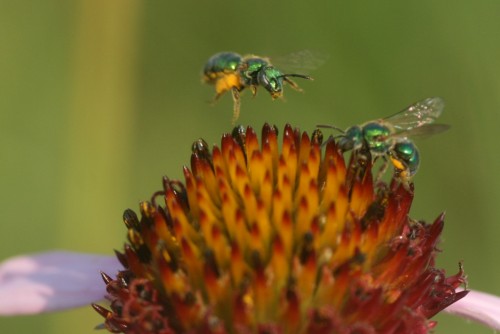
Augochlorella striata (aurata), photographed by Gretel Kiefer.
This is a guide to the bees that visit Echinacea at our study site in Minnesota during the summer field season. The Echinacea Project has collected over 900 specimens and 43 species of native bees. Each page of this guide includes a description of a native bee taxon to be used for quick identification (as well as the link to DiscoverLife to be used as a tool in more accurate identification) and life history traits such as nesting and foraging habits. Also included are the common name of a genus, the number of species and specimens The Echinacea Project possesses of these genera and species, and pictures and videos from the Echinacea Project Youtube of the bees collecting pollen on Echinacea in the field. The pages are organized by both family and genus, and information on individual species within a genus are included where we have that information.
These solitary, generalist bees show great variation in both their physical traits and their life history characteristics. They range in size from 3 mm to over 20 mm long. In shape, bees like the small, black, ant-like Lasioglossum can appear completely unrelated to the larger more hairy Halictus, though they are both part of the Sweat Bee family, Halictidae. (Mader et al. 230, 237)
Furthermore, each genus nests and forages differently, from solitary to semi-social to communal, from digging their own nests in the soil to nesting in existing holes in wood or plant stems. Variation among nesting patterns can even be seen within genera. A solitary bee constructs a nest of her own or uses a nest in an existing crevice and forages solely for herself and her brood. (Mader et al. 27) Unlike solitary bees, groups of eusocial bees contain certain caste roles, in which each individual has his or her own job to help the group survive. In native bees, this is generally seen among a series of generations of one lineage, in which the founding bee serves as the queen, her offspring serve as the female workers, and the male drones wait to mate with the new queens in the fall. Communal bees nest together, but generally show solitary behavior, a single member providing only for her own brood. However, cooperation among communal bees has been studied, such as working together to build the nest and certain bees serving as guards at the entrance. (Mader et al. 35-45)

Andrena, photographed by Gretel Kiefer.
In contrast to solitary bees, social bees such as honeybees and bumblebees are attracted to the nectar stores of native plants, which they use to create energy-rich honey for their offspring. Social bees are not visitors to Echinacea on our study site, perhaps because they are less likely to visit plants with less bountiful nectar, such as Echinacea. Solitary bees do not produce honey and are attracted to a wide variety of plants for their pollen, which they bring back to their nests to feed their larvae.
Foraging habits are more or less consistent among the collected native bee specimens. The vast majority are generalists, meaning they visit many species of flowering plants, imposed by their tongue length and size (Mader et al. 32).
The Echinacea Project has conducted several studies on pollinators, including one published in 2010, under the direction of Stuart Wagenius and Stephanie Pimm Lyon, which studied pollen limitation vs. pollinator limitation in Echinacea. Results showed that, in both years of the study, bee visitation actually increased with isolation of individual plants and did not vary significantly with population size. As expected, plant isolation increased pollen limitation and lowered seed set. This means that pollen receipt limits reproduction in Echinacea but pollinator visitation does not. The hypothesized causes of pollen limitation that are consistent with these surprising results include: incompatibility, pollen quantity, the identity and density of local co-flowering plants, and the synchrony of flowering. (Wagenius and Pimm)
Links to Bee Families:
Apidae – Apis, Bombus. Ceratina, Melissodes
Halictidae – Agapostemon, Augochlorella, Halictus, Lasioglossum
Megachilidae – Coelioxys, Heriades, Megachile
And for further use in identification, there is a helpful guide for Echinacea-visiting bee identification, created by team member Stephanie Pimm.
References:
Mader et al. Attracting Native Pollinators: Protecting North America’s Bees andButterflies. 2011. The Xerces Society.
Wagenius, Stuart and Pimm Lyon, Stephanie. “Reproduction of Echinacea angustifolia in fragmented prairie is pollen-limited but not pollinator-limited”. Ecology, 91(3), 2010, pp. 733–742. 2010. The Ecology Society of America.
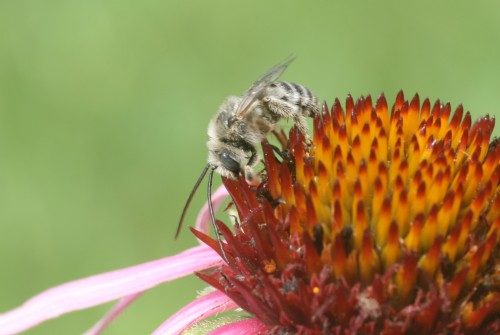
Melissodes, photographed by Gretel Kiefer
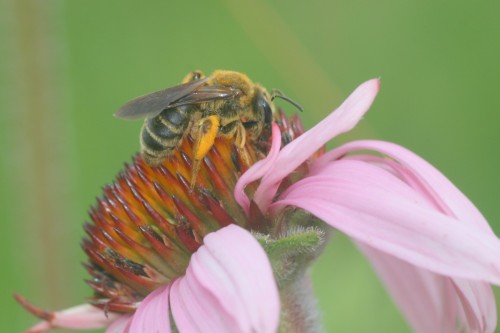
Andrena, photographed by Gretel Kiefer
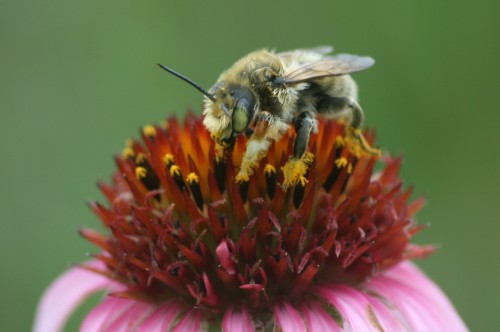
Megachile, photographed by Gretel Kiefer
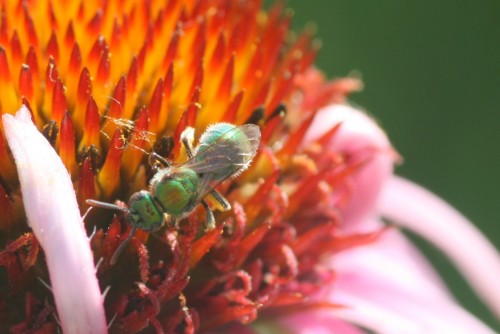
Augochlorella aurata, photographed by Gretel Kiefer

